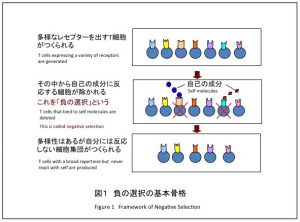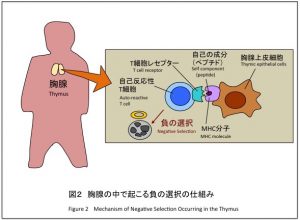負の選択=Negative Selectionは自分にとって
危険なT細胞を取り除く仕組みです。
T細胞は、リンパ球の一種で、免疫細胞の司令塔のような役割りを果たす細胞です。負の選択は「胸腺」というT細胞をつくる組織の中で起こります。胸腺の中では、まず幼若なT細胞の中で個別に遺伝子再構成が起こり、いろいろな反応性をもつT細胞レセプターを出す細胞がつくられます。この仕組みにより、いろいろな病原体と戦えるT細胞がつくられます。しかし、一方で自分を攻撃してしまうような危険な細胞もつくられます。そして、それらの危険な細胞を除く仕組みが、負の選択です(図1)。
どうやって危険な細胞を除くのでしょうか。胸腺の中では、例えば本来は膵臓でだけ作られるインスリンのように、自分自身の体のいろいろな組織にある様々な分子と同じ分子がつくられています。多様なT細胞レセプターの中には、そのような自己の分子と結合するものが存在します。
そして、そのようなT細胞レセプターを出しているT細胞は、自己の分子との結合により、強いシグナルを受け、死んでしまいます(図2)。

T細胞側からすると、自分が結合できる相手の分子を胸腺の中で探すのですが、ぴったり合う相手と出会ってしまうと、死ぬ事になってしまう訳です。この仕組みがうまく働かないと、上記の例ではインスリンを作る膵臓を攻撃するT細胞によって膵臓が破壊され、自己免疫性の糖尿病になってしまうのです。 胸腺の中では、胸腺上皮細胞がT細胞の分化を支持する一方、自己の分子を出すことによって負の選択を誘導しています。少し詳しく言うと、MHCという分子の上にペプチドという小さいタンパク質の断片の形で提示されます。 なお、負の選択は、CD4とCD8という分子をどちらも発現する共陽性(Double Positive, DP)細胞段階から起こり始めます。
Happy DeePeeという曲名は、このDP細胞に由来します。
<文責:河本宏>
“Negative Selection” is a mechanism by which T cells dangerous for your body are deleted. T cells are a type of lymphocytes, which play a role as commanders of the immune system. Negative selection takes place in the “Thymus”, the organ specialized to support T cell development. In the thymus, rearrangement of T-cell receptor genes occurs in each immature T cell, and thus T cells carrying a variety of reactivity are firstly generated. By this mechanism, a huge repertoire of T cells that come to be able to attack a broad range of pathogens are formed. On the other hand, T cells that may react against self tissue and thus harmful to your body are also generated. Negative selection is a process to delete such potentially harmful T cells in the thymus (Figure 1). How are such dangerous cells deleted? In the thymus, molecules that is expressed in various tissues are also produced. For example, insulin, a protein produced in pancreas, is also produced in the thymus. Among a variety of T-cell receptors, there exist those which can bind to such self components. Such T cells that express T-cell receptors binding to self components will receive strong signal by the binding, and this strong signal induces suicide of such cells (Figure 2). From the view point of T cell side, each immature T cell seeks for his “partner” molecule in the thymus, and he comes to take death fate when he meets the partner of a perfect match. If this mechanism fails to work, in the above mentioned example, T cells that react with insulin may survive, go out of thymus, and destroy insulin producing cells in pancreas, resulting in the development of diabetes mellitus of autoimmune type. In the thymus, thymic epithelial cells support T-cell development on one hand, while induce negative selection on the other hand, by expressing self components on their surface. In detail, such components are presented as a peptide, a fragment of protein, on the presenting molecule called MHC. This process starts at the stage of double positive (DP) cells where both CD4 and CD8 molecules are expressed. The title of our song “Happy DeePee” was named after the DP cells.
<Author: Hiroshi Kawamoto>